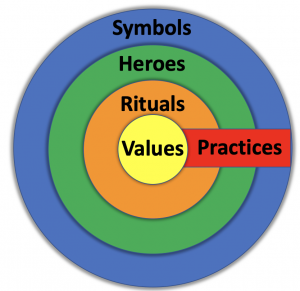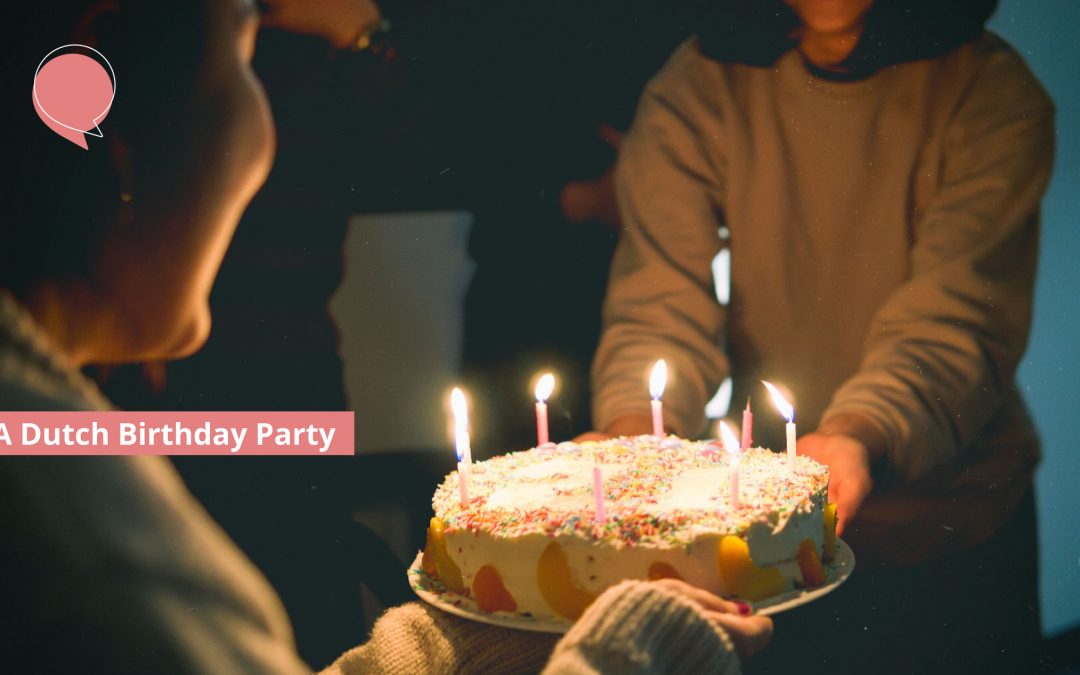May 2023 | Written by – Willem Van Hoorn
In this edition of the blog I´d like to take a look with you at the inner workings of Dutch birthday parties. You stand a fair chance of occasionally skimming past such an event at work or study. And you may even one day find yourself to be invited to one.
(In the latter case, by the way: lucky you! Given the relative separation that many Dutch people tend to maintain between their work or study and their private lives, if you’re invited to a birthday party, you are surely ‘one of the gang’)!
A bit of theory first
Before we will go into some specifics, let’s have a little underlying theory first. The practices we observe surrounding birthdays (and, for that matter, surrounding childbirth, weddings, farewells, and other ceremonies) are ranked among the ‘rituals’. A ritual is ‘a procedure in which the actions and wording follow a more or less prescribed form and order’.
When the late cultural specialist professor Geert Hofstede (known best for the Hofstede Cultural Dimensions) published his ‘onion model of cultures’ (2001), he embedded rituals firmly in that model.

In the outer shell of his cultural onion model are the ‘symbols’. Here you find cultural artifacts like flags and banners, traditional clothing, the way people wear their hair, and so on.
The next layer, going inward, is the layer of the ‘heroes´. Each culture has one or more heroes. A hero in a particular culture is an exponent of the values of that culture. Meaning also to say that different cultures have different heroes.
The next inward level in the onion is the level of the rituals. How people greet, eat their meals, engage with one another at work, in their social activities, how they practice their religion, and so on.
The innermost layer, finally, is the layer of the values. This layer underpins the practices in the other three layers. Here you find the cultural assumptions, the norms and values and fundamental attitudes. This layer is more or less implicit. It is the ‘of course level’. Many people are not even aware that they hold these values, and that other people may have other core values, with equally good intentions.
In general: the more you are on the outside, the easier it is to talk about it, and to make changes. And the more you move to the inside, the more it is perceived as ‘self’. And misunderstandings there may lead to serious discomfort. As an example (in the layer of rituals): if two people greet one another, and the one expects to keep a distance and bow, while the other embraces him or her and gives a solid hug, you definitely have a recipe for frustration!
Some specific rituals around Dutch birthdays
At work
For starters, one birthday ritual at work. In the Dutch work (or study) context: if you are the birthday boy or girl, then you are the one who is expected to treat your colleagues to something nice, on the day itself, or one close to it. Cake, cookies, fruit (for those who like a healthier approach), something like that. This may be different from what you are used to, as in many countries it is the other way around.
The benefit of this obviously being that, if you work in a team of some size, you will be treated in turn, on a regular basis.
What to bring, or not
There is a considerable difference between different cultures regarding what you bring to a party or not. In some cultures it comes close to an insult if you bring food or drinks to a party, as you seem to imply that you are not sure if your host will take good care of his or her guests. On the opposite side: there are also cultures where a birthday party is more or less by definition a ‘BYOB event’ (Bring Your Own Booze), and if you don’t bring something that is being looked upon as a sign of frugality.
In the Dutch context I would say that it is perfectly alright to bring a bottle of wine, some (specialty) beers (both gift wrapped) of a (posh) juice to a birthday party. But do not be surprised if your host will set it aside, and not put it with the drinks for the day. He or she may reserve it for a future occasion. Or at least ask your permission to put it with the drinks for the party. It is primarily looked upon as a gift, after all, and not necessarily as your contribution to the party.
When it comes to bringing food, I would recommend you check with your host first: “Hey, I am passionate about baking cakes (or quiches, making salads, soups, whatever)….. would you like it if I brought one”? That way you leave your host some room to maneuver.
Congratulate everyone
There is one birthday ritual that, as far as I know, is uniquely Dutch. And over the years I have asked many international friends and colleagues about this. When you enter a birthday party, you obviously congratulate the birthday boy or girl, and you give your gift: happy birthday (in Dutch: “gefeliciteerd met je verjaardag” (audio file).
But (and here is the difference): it is custom that, after that, you also congratulate all the others present on the occasion: “congratulations with [the birthday kid]” (gefeliciteerd met ……’), all the while introducing yourself. Traditionally you do so by going around the room, shaking hands, and delivering the congratulation message. Occasionally some Dutch person finds that a bit too much of a good thing, but then they will usually still make a gesture towards those present: “gefeliciteerd, iedereen” (congratulations, everyone).
There is no consensus about the origin of this rather particular Dutch birthday ritual. But we can certainly put it in a social context. It may feel a bit uncomfortable, in the beginning, but at least: after performing this rather laborious ritual, you have ‘met’ all those present, you have introduced yourself (don´t try to remember all the names), and so on. In other words: for the Dutch, who sometimes tend to be a bit reserved in (the beginning of) social encounters, it serves as an icebreaker. After that you are ‘on the inside’, and free to continue the conversation at a later moment. An easy starter topic for that being: exploring how you are both related to the birthday kid.
On different occasions I have heard from international friends something like: ‘And then at the birthday party someone walked up to me, shook hands and said ‘gefeliciteerd´. So at first I figured he had just introduced himself, and that his name was ‘Gefeliciteerd‘. But then the next one came in and said the same. And the next one, and so on and so forth. It took me a while to figure-out what was actually happening there’ 🤣.
Gifts are unpacked on the spot
In some cultures, the unpacking of birthday gifts is reserved for a later moment. Not so, however, in the Netherlands. A gift is unpacked right there and then, in front of all those who stand around. You may debate the wisdom, but this is how the game is being played here.
And this knowledge may also serve as a little warning against bringing a gift that may be a bit inflammatory if it is opened in front of the receiver’s parents, his or her girl- or boyfriend or children.
A birthday calendar
 Finally, for now: in almost every Dutch house you will find a birthday calendar (verjaardagskalender). And they come in a variety of designs, there is one for every taste. On that calendar the Dutch put the birthdays of all their friends and family members, to make sure they will not forget one. Especially people from strongly relation oriented cultures highly appreciate this: a calendar on which you put everyone who is dear to you!
Finally, for now: in almost every Dutch house you will find a birthday calendar (verjaardagskalender). And they come in a variety of designs, there is one for every taste. On that calendar the Dutch put the birthdays of all their friends and family members, to make sure they will not forget one. Especially people from strongly relation oriented cultures highly appreciate this: a calendar on which you put everyone who is dear to you!
But there is a little ‘however’ attached to this. Somewhere in the process the practical Dutch mindset kicks-in. They make sure they put the birthday calendar in a place where they are sure to see it every day. Do you know where the Dutch people hang this calendar with all the people who are dear to them?
(If you don´t, just ask a Dutch colleague or friend……)

